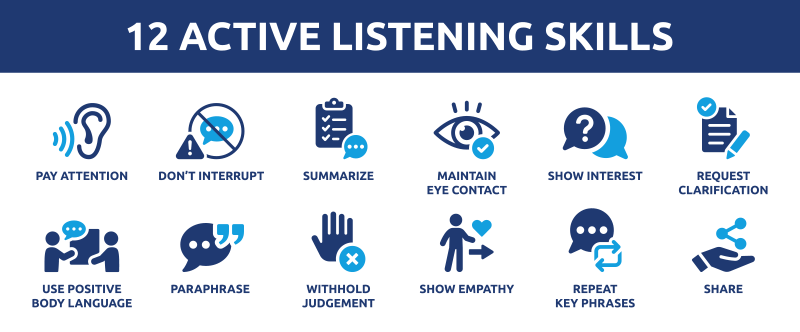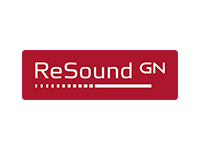
- Jun 12, 2023
Using Conversation Visual Cues
Visual cues play an essential role with individuals who may have trouble hearing. Spoken words may be challenging to comprehend. In these cases, visual cues provide important visual information that complements or replaces the auditory input.
Efforts to create a friendly and welcoming atmosphere are genuinely appreciated and valued. Here are some common conversation visual cues that you can use.
1 Facial Expression: The face is a powerful tool for self-expression. Facial expressions such as smiling, frowning, raising eyebrows, or wrinkling foreheads convey various emotions.
2 Eye Contact: Maintaining eye contact indicates attentiveness and engagement in a conversation. This shows that you are actively listening to the other person.
3 Body Language: Body movements and positions can communicate different messages.
- Leaning forward may indicate interest, while leaning back may signify relaxation and disinterest.
- Open and relaxed body posture generally reflects openness and communication.
4 Hand Gestures: Hand movements can add emphasis, clarify meaning, and provide visual cues. For example, pointing to something, waving goodbye, or using hand gestures to indicate size or quantity.
5 Nodding: Nodding the head up and down can signify agreement, understanding, or encouragement. This can indicate that you are actively listening and processing the information shared.
6 Posture: Posture while conversing can be a real game changer. Your posture can convey confidence or submissiveness.
- Standing tall: reflects confidence.
- Slouching and hunching: suggest disinterest or lack of confidence.

7 Proximity: Distance between individuals during conversation may convey meaning. The appropriate distance between two people varies across cultures and contexts.

8 Touch: Handshakes, pats on the back, or a friendly hug can convey warmth. Take note of different cultural norms and personal boundaries.
9 Microexpressions: Microexpressions are fleeting facial expressions that occur quickly and often unconsciously. They can reveal underlying emotions or thoughts a person may try to conceal.
Understanding and paying attention to these visual cues can enhance communication skills, help gauge other people's reactions, and improve overall understanding during a conversation.

Dr Paul Ekman
Before Dr Paul Ekman's work in the 1970s it was believed that facial expressions signifying emotions were learned from those around us. Ekman's studies showed that people from very different cultures often used the same facial expressions to display the same emotions.
Ekman's findings suggest that a far more likely explanation is that emotional facial expressions are a fundamental evolved property of the brain.
Dr Dean Burnett Emotional Ignorance - Lost and Found in the Science of Emotion
How to be more effective in communication
Effective communication requires practice, patience, and understanding. Here are a few tips to keep in mind.
1 Face the person directly: Maintain good visibility of your face; this allows a good view of your facial expressions, lip movements, and gestures which are essential for effective communication.
2 Speak clearly and naturally: Enunciate words and maintain a natural pace. Avoid exaggerated lip movements or speaking too slowly.
3 Use visual context: Use hand gestures, body language, and other visual cues to support your verbal communication. refer How Context Shapes Conversation
4 Create a comfortable environment: Minimize background noise and distractions to focus on the conversation.
5 Engage in active listening: Show genuine interest and engagement through active listening and behaviours. Nod your head, provide affirmative facial expressions, and maintain eye contact. 
Refer Active Listening Vs Deep Listening
6 Be patient and respectful: Allow extra time for the person to process and respond to the conversation. Avoid interrupting or finishing their sentences. Be patient and allow them to express their thoughts fully.
Incorporating these visual cues and strategies can make conversations more accessible and inclusive. It's helpful to have an open discussion about specific communication needs and preferences to ensure effective communication and understanding..
Inclusivity means embracing diverse communication methods and adapting to ensure everyone's voice is heard, regardless of their hearing abilities!
Tags
Other Articles
05/12/2023 Understanding Body Language In Meetings »
21/11/2023 Slim Hearing Aids »
18/06/2023 Noise and non-hearing health »
03/01/2023 A beginner's guide to Bluetooth »
08/12/2022 The Stigma of Wearing Hearing Aids »
16/08/2022 How to Become a Better Listener »
13/05/2022 Negativity Bias »
22/04/2022 Tinnitus who has it and why? »
14/10/2021 Lost or Damaged Hearing Aids »
20/10/2020 Deep Listening »
08/10/2020 Over-the-Counter hearing aids »
08/09/2020 Hear Better than Anyone in the Room »
12/08/2020 Sound Wavelength and Loudness »
03/03/2020 Localisation - identifying where sound comes from »
10/02/2020 Sudden Deafness »
17/12/2019 Hearing Better in Meetings »
09/12/2019 Can meditation improve hearing? »
18/11/2019 Over 50s »
30/10/2019 Wireless Hearing Aids »
07/10/2019 Cleaning and Maintaining Hearing Aids »
09/04/2019 What is the process for buying a hearing aid? »
06/02/2019 One Hearing Aid or Two? »
31/01/2019 Hearing Aid Cost Breakthrough 2019 »
29/08/2017 Hearing Aid Future is Here »
09/06/2017 ABC Checkout Warns on Hearing Aid Purchases »
13/04/2017 Listening better in a noisy world »
21/02/2017 Hearing augmentation devices - IQBuds »
08/12/2016 Childrens Hearing Linked to Social Disadvantage »
24/10/2016 Hearing with Less Effort »
25/01/2016 Seven Thousand Ways to Listen »
01/10/2015 Hearing Loss and Dementia »
06/03/2015 Myth: Hearing Aids do not work »
03/12/2014 ABC Background Briefing Hearing Aids »
20/11/2014 Buying a hearing aid for your parents »
17/01/2014 Is Bluetooth making costly Hearing Aids redundant? »
13/01/2014 Research Online and Save »
08/10/2013 Phonak Q10 Hearing Aid Review »
13/05/2013 Is anyone listening to you »
12/04/2013 Hearing Aid Repairs »
05/04/2013 Will I benefit from a hearing aid? »
18/03/2013 Compare Hearing Aids »
13/03/2013 Audiologists are now mobile »
08/03/2013 Hearing and your work prospects »
18/12/2012 Hearing and your baby »
13/12/2012 Occlusion effect when wearing hearing aids »
24/10/2012 Hearing Aid Brands in Australia »
18/10/2012 ReSound Verso »
03/10/2012 Waterproof Hearing Aids »
28/05/2012 Music to your ears »
19/02/2012 Donate hearing aids that are no longer needed »
31/01/2012 An Invisible Hearing Aid »
26/11/2011 Who to see for sudden hearing loss »
03/11/2011 Restore your hearing or use aids »
13/09/2011 Not wearing your hearing aids »
29/08/2011 Audiologists Career Path »
26/08/2011 Bluetooth Hearing Aids »
Hearing Aid Referral
Get the best price and care from our network of professionals
FREE/no obligation
- Great Care
- Major Brands
Hearing Aid Brands in Australia









